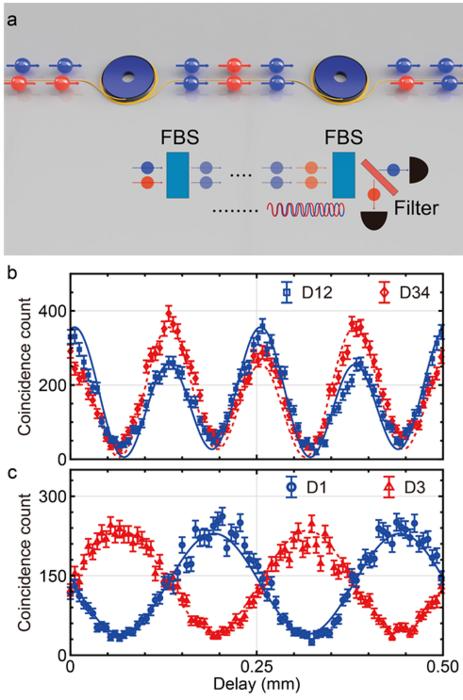In the journal Light: Science & Application, a group of researchers led by Professor Heedeuk Shin from Pohang University of Science and Technology, Korea, created a new kind of quantum entanglement in which photons are linked by their frequency instead of their path. This advancement in quantum physics utilizes a novel instrument known as a frequency beam splitter, which can modify the frequency of individual photons with a success rate of 50%.
 a, An experimental schematic for the frequency-domain entanglement. Two photons with distinct colors, red and blue, are injected into the interferometer constructed with two frequency beam splitters. Then, the resultant interference pattern is measured. b, The measured interference pattern with the two-photon NOON state, shows a two-fold enhancement in resolution compared to the single-photon counterpart. c, The measured interference pattern with the single-photon state. Image Credit: by Dongjin Lee, Woncheol Shin, Sebae Park, Junyeop Kim, and Heedeuk Shin.
a, An experimental schematic for the frequency-domain entanglement. Two photons with distinct colors, red and blue, are injected into the interferometer constructed with two frequency beam splitters. Then, the resultant interference pattern is measured. b, The measured interference pattern with the two-photon NOON state, shows a two-fold enhancement in resolution compared to the single-photon counterpart. c, The measured interference pattern with the single-photon state. Image Credit: by Dongjin Lee, Woncheol Shin, Sebae Park, Junyeop Kim, and Heedeuk Shin.
Spatial-domain photon number-path entanglement is a major actor in quantum metrology and information science and has been studied by scientists for many years. This idea entails photons arranged in a unique pattern called NOON states, where they are all in one pathway or another.
This concept opens up revolutionary applications, such as super-resolution imaging that goes beyond conventional boundaries, improving quantum sensors and creating quantum computing algorithms for tasks requiring extraordinary phase sensitivity.
Researchers have developed entangled states in the frequency domain, similar to spatial-domain NOON states, but have one important difference: Photons are distributed between two frequencies rather than being divided between two paths.
The ability to produce two-photon interference with twice the resolution of its single-photon counterpart has been demonstrated by successfully generating a two-photon NOON state within a single-mode fiber. This demonstrates extraordinary stability and potential for future applications.
In our research, we transform the concept of interference from occurring between two spatial paths to taking place between two different frequencies. This shift allowed us to channel both color components through a single-mode optical fiber, creating an unprecedented stable interferometer.
Dongjin Lee, Study First Author, Department of Physics, Pohang University of Science and Technology
This revelation opens up new possibilities for quantum information processing in the frequency domain and deepens the understanding of the quantum universe. The investigation of frequency-domain entanglement may lead to exciting developments in quantum technologies that could influence anything from secure communication networks to quantum sensing.
Journal Reference:
Lee, D., et al. (2024) NOON-state interference in the frequency domain. Light: Science & Applications. doi.org/10.1038/s41377-024-01439-9
Source: http://english.ciomp.cas.cn/